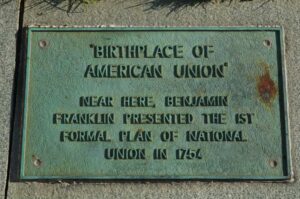
Fact: The Iroquois Nation and Benjamin Franklin jointly founded the future government of the United States of America with the Albany Plan of Union 1754 – in Albany, NY.
Fact: Albany is the second oldest city in the state of New York.
Fact: The Constition includes many elements from the Albany Plan of Union with the cooperatoin of the Iroquois once more:
On June 11, 1776 while the question of independence was being debated, the visiting Iroquois chiefs were formally invited into the meeting hall of the Continental Congress. There a speech was delivered, in which they were addressed as “Brothers” and told of the delegates’ wish that the “friendship” between them would “continue as long as the sun shall shine” and the “waters run.” The speech also expressed the hope that the new Americans and the Iroquois act “as one people, and have but one heart.”*
Fact: New York is called the “Empire State,” because George Washington considered it the “seat of the nation.”
Fact: The first capital of the United States was in New York City at Federal Hall.
Fact: George Washington was inaugerated in New York City at Federal Hall.
Fact: The first United States Congress met in New York City at Federal Hall.
Fact: Western New York was known as the Burned-over District the Holy Spirit was strongly over the area, yet there was contention because precious doctrines were removed from the Bible (1 Nephi 13:15, 29). The devil doesn’t want people to understand the gospel. He caused the abominable church to remove doctrine, and this caused Christians to stumble as they did in the Burned-over District of Western New York. Other verses could be cited depicting our current state of thousands of denominations, many set-up to get gain, that is not found in any other country.
Endnotes
*See Charles Thomson’s “History of the Articles of Confederation,” (this work was secret during the revolution) in Papers of the Continental Congress,1774-1789 in National Archives (M247, Roll 22, Item No. 9 for a June 11, 1776 notation entitled “Resolved that a Committee be appointed to prepare and digest the form of a confederation to be entered into between these Colonies;” on the next day, Thomson noted that committee members were appointed. By July 12, 1776, Thomson notes that Article II of the draft of the Articles of Confederation stated that the “Colonies Unite themselves so as to never be divided by any act whatsoever, and hereby severally enter into a firm League of friendship with each other.” This phraseology is similar to the Canassatego speech of 1744 at Lancaster that was reiterated by the Americans at the Albany conference of 1775. See also “Josiah Bartlett’s Notes on the Plan of Confederation,” [June 12-July 12? 1776] (notice heading in Barlett’s notes entitled: “By the Albany Plan”) in Smith, ed., Letters of Delegates, IV, pp. 199-201. It is probable that Bartlett started these notes the day after the Iroquois chiefs named John Hancock, the “Great Tree” in Congress. Also see Smith, ed., Letters of Delegates, IV, p. 252, editorial note. This editorial note states “there can be no doubt that the members of the committee began their work with a copy of Benjamin Franklin’s Proposed Articles of Confederation before them, for which see Ford, ed. Journals, II, p. 195-199. Several passages from Franklin’s plan can be found verbatim in the Bartlett and Dickinson drafts and many others survive with slight variations. Indeed, . . . the 4th, 7th, 8th and 12th of Franklin`s Thirteen Articles are conspicuously incorporated into the committee’s work.”
**For more detail regarding the naming of Hancock by the Onondagas, see Ford, ed., Journals, V, p. 430. In this ceremony, the Iroquois sachems are resolving their concern about the nature of the executive in the Continental Congress that they expressed in the previous year at the August 31, 1775 treaty meeting at Albany, New York (see “Proceedings . . . with the Six Nations, 1775,” Papers of the Continental Congress, 1774-89, National Archives (M247, Roll 144, Item No. 134). It is also interesting to note that Thomas Jefferson (author of the Declaration of Independence) and James Wilson (principal author of the first draft of the Constitution) were on the Standing Committee on Indian Affairs in the Continental Congress during 1776 (see Ford, ed., Journals, VI, p. 1050). Formal and informal relations with the Iroquois continued throughout the revolutionary era. An Oneida woman, Polly Cook, served as George Washington’s cook during the revolution. The Oneidas also brought corn to Washington’s troops during the bitter winter at Valley Forge thus enabling the Continental Army to survive. See Cara Richards, The Oneida People, (Phoenix: Indian Tribal Series, 1974), pp. 53-54. (Source http://www.ratical.org/many_worlds/6Nations/ See also http://www.believersweb.org/view.cfm?ID=173 )